This colorful episode marks the beginning of the bi-centary celebration of
the Battle of Loano, a little know victory but the first engraved on the Arc de
Triumphe in Paris. Although not present at the battle, Napoleon gave strategic
direction and planning for the series of battles that opened up the following
year's campaign for Italy.
At the end of the 18th Century, each frontier of the Republic that had
arisen from the Revolution constituted a front. The Italian frontier was no
exception. Because of the nature of its geophysical terrain and the relatively
little importance given to Piedmont as an adversary, the operations languished
and the French Ministry of War considered them of secondary importance. By
chance, at the beginning of 1794, the ambitious General Buonaparte was
assigned as Artillery Inspector of the Army of Italy.
Insecurity
The assignment was ill-suited to produce battlefield laurels. Napoleon, in
order to impose his own operational ideas, knew how to play on the insecurity
that the political leadership had instilled in its generals. Dismissals,
imprisonment and the guillotine were often the lot of unsuccessful
commanders. He first gained the support of the political commissars Cristoforo
Saliceti and Augustin Robespierre (the brother of Maximilien Robespierre).
Then he succeeded in persuading General Pierre Dumerbion, the
Commander of the Armee d'Italie, to accept his scheme of a diversion on the
strong positions of the Piedmontese in Saorgio, against which French attacks
had failed for two years. In the meantime, the main effort would be developed
on the coast in the direction of Savona. About two weeks later General Andre
Massena reached Loano and, at the beginning of May 1794, he took the
mountain passes which gave access to the Pianura padana, the plain of the
River Po. Napoleon had wanted the campaign to continue, but his peremptory
suggestions went against Minister Lazare Carnot's intentions.
Carnot was convinced that it was not worthwhile sacrificing forces
on the Italian front which could affect the one on the Rhine. Buonaparte's view
was that the war against Austria had to be won, but by forcing that country to
withdraw from the Rhine in order to plug the gap in Italy.
Napoleon's viewpoint was one of grand strategy, ranging far and
wide over broad horizons. In the meantime the General was sent to Genoa
to occupy himself with less important administrative matters - a poor
assignment for his ambitions. It was above all risky in that it coincided with the
coup d'etat of 9 Thermidor - 27 July 1794. Buonaparte was imprisoned and had
to find inexhaustible excuses to avoid the worst.
Waiting for clarification of Napoleon's personal affairs, the Armee
d'Italie was champing at the bit. The General's worries were justified: Austria
was beginning to worry about the Italian front and had decided to reinforce it.
Not only this but Austria and Piedmont were collaborating, an arrangement that
until then had meant little more than verbal co-operation.
During this pause in circumstances, whilst discussing strategy, a suggestion made by Napoleon was accepted. This was that to hold the front it would be necessary that
Savona remained French. The Armee could then penetrate along the River Bormida in such a way as to divide the Piedmontese and the Austrians, thereby threatening to surround the latter.
Swift Campaign
A swift campaign which began on the 19 September was unexpectedly
highly successful. By the 24th, however, General Dumerbion considered that
his exhausted forces had to establish more secure positions by falling back a
considerable distance and setting up a new front line.
The oscillations in the fortune of Napoleon corresponded closely with
the operations on the Italian front. Involved in one of the periodic expulsions of
supernumerary officials and then overwhelmed by the flaring up of his pride,
only in the summer of 1795 did Napoleon return to the situation in Italy.
In fact, following the offensive taken by the Austrians on 29 June, General
Francois Christophe Kellerman, the new Commander of the Armee d'Italie,
had been driven back to Loano. The Bureau Topographique (more or less
the French General Staff) recalled Buonaparte because of his accurate
knowledge of the front.
He had just completed detailed reports on the subject when he found
himself yet again in an awkward situation on the 15 September. The difficulties
Buonaparte experienced in his career came to an end on 5 October -13
Vendemiare. This was the day he fired on those demonstrating in front of the
Tuilleries. It was also the day of the French, who were about to attain a
victory, advanced in Italy.
Italy First
Napoleon strongly advised the withdrawal of the troops from the Rhine
and the Pyrenees in favour of the Italian front, in order to recover the lost
positions and to finally divide the Austrian troops from those of Piedmont.
Buonaparte's point of view was accepted, but put into practice over too long a
period of time. Operations came to a standstill when serious conflicts arose
between the rapacious Austrian Commander in Chief, General Baron De Wins,
who was mainly involved in the plunder of Liguria, and his Piedmontese
equivalent Lieutenantgeneral Baron Michelangelo Alessandro Marchini Colli. Colli
was also supported by notables from Genoa, but even though the French were
also affected by the delays, these proved advantageous in their case.
The lull in operations gave Kellerman the opportunity to reorganise his
own troops now positioned on the Borghetto line. Based on a mountainous
rampart, it started from Loano, and cut across the Maritime Alps to join in the
defence of the River Tanaro. The rugged terrain of the Western Ligurian
mountains heavily restricted the lines of communication whilst at the same time it proved effective as an excellent defence.
In addition the Piedmontese and Austrian troops, although well
drilled, were disoriented because their training did not include
mountain combat. It was too static and tied to defensive tactics.
The French were not affected by such limitations. Their demi-
brigades (the term "regiment" was abolished during the Revolution
because it had strong ties to traditional noble connections) had not
been so strictly drilled and therefore were not particularly
preoccupied by tactical principles. This was actually to their
advantage since it rendered them more flexible than other
detachments.
Courage
They were led on by the impetuous courage of their
young officers, who were full of idealism for the Republic.
The French armies travelled lightly with only their basic
needs and consequently were not encumbered with
excsssivs equipment and provisions. Admittedly, the men
themselves were in great need of shoes, the chronic
shortage of which characterised the campaigns of the Republican
period. This the lack of shoes would affect their fighting and
marching ability, not unlike the situation in the summer of
1795.
While the French were protected behind the line of the
Borghetto, their adversaries organised defensive positions
on the opposite bank. the Austrians positions ran from
Borghetto situated one kilometre west of Loano) to the Scravaion.
This is a pass cutting between the summit of the extremely sheer and
rugged mountains, in particular those extending down to the coast.
The Piedmont troops were lined up from Scravaion to Garessio,
following the Tanaro Valley on and on until the Tenda Pass.
the Piedmontese were the only ones to maintain pressure
on the French during the summer months.
These operations were for all practical purposes ineffective.
They were organised by General De Wins, who for his part avoided
exposing his command to the risk of an offensive. He was aware
that Prussia and Spain were possibly in the process of abandoning
the First Coalition, in which case the French could troops to the
Italian front, as suggested by Napoleon. The Austrian Commander
had no wish to provoke reinforcement of his adversary in the
Castelvecchio area by attacking the French on the 19 September.
Weak Attack
The attack by Austrian General Count D'Argenteau's army
corps was not a particularly strong one, but it resulted in failure as it
was directed against the strongest point of the French line. Known
as "Little Gibraltar", some soldiers were entrenched and some were
defended by a redoubt consisting of a high dry-stone wall. A
determined counterattack, however, allowed the French to
conclusively overturn the situation in their favour within a
few hours.
The new commander suggested that it was not possible to
carry out the plan that had been decided upon in August by
the Committee of Public Safety, based upon Napoleon's first
thoughts. He proposed an attack on the village of Ceva, intended
to separate the two coalition armies, followed by the recapture
of Vado, near the city of Savona. It was too ambitious an
objective for the Armee d'Italie which, although having reached
the strength of 33,000 men, was still outnumbered by the 30,000
Austrians and 12,000 Piedmontese.
Reshuffled Plan
The plan was therefore reshuffled by Scherer and
Massena, although preserving the intention of dividing the
Piedmontese from the Austrians. Now the main body of the
French army would attack the troops of Colli at Garessio and
Mount Spinarda, outflanking the Imperials in the Scravaion Pass
which acted as the hinge between the two armies. At the same
time the remainder of the Armee d'Italie would fix the Austrians
with a demonstration between the pass and the coast.
The movements behind the French lines did not escape the
Piedmontese commander. He took all the precautions he could, but
both his plans and also those of Scherer were nullified by the
abundant snowfall of the 15 November. The conditions of intense
cold, coupled with inadequate clothing and equipment, made it
impossible for the any units to remain on the harsh Ligurian
mountains.
The subsequent French attack began right from this area, in
accordance with a new plan devised by General Massena. The
manoeuvre was rather simple: fixing the flanks and breaking through
the centre. The key of success depended on the element of surprise,
the achievement of which was helped by the exchange of command
between De Wins, who was disliked by both the Austrians and the
Piedmontese, and General Baron Wallis, and also by the adverse
weather conditions.
Bad Weather
The bad weather in particular made it extremely likely
that the French units would withdraw to their billets and convinced
the elderly Austrian commanders that operations would be resumed
only in the following spring.
The Revolution had broken the rules traditionally followed by
the armies and inclement weather had now become a part of
the elements to be exploited in order to attain success.
During the night of the 22 November, the Austrians descended
from the summit and the ridge to make their way to the winter
quarters prepared at the bottom of the valley. Without disturbance
the 25,000 French soldiers completed their manoeuvres of approach
to the enemy lines, now sparsely guarded by depleted detachments.
The Austrian-Piedmontese armies consisted of more than
44,000 men scattered between Savona and the Col di Tenda Pass.
Although 19,000 Austrians were drawn up between the coast and
the Castle of Rocca Barbena, there were few defenders in the zone
where the French had attacked. In contrast, having been forewarned
by their informers, the Piedmontese, arranged between Rocca
Barbena and the valley of Tanaro, were ready for action, as
demonstrated by the facts of the day of the 23rd.
The French attacks began early. One, conducted by General
Miollis, was directed to the Valley of Tanaro, west of Garessio. The
other, led by Serurier, was aimed at the San Bernardo Pass to cut the
road to Rocca Barbena. By mid-morning the French found themselves
in great difficulty in both directions, whilst the Piedmontese
manoeuvred their units and cleverly exploited the hard terrain to
fire incessantly upon the enemy with their muskets and cannons.
The fact that Serurier had already begun to withdraw at
midday, without losing touch of the enemy, should not be taken as an
indication that this attack of the future Marshal was a weak one. The
task entrusted to him that day was carried out, namely to detain the
Piedmont army in its proper positions. This prevented it from assisting
the Imperial troops who were being subjected to greater pressures
by Massena.
In fact Massena, who was in charge of more than 13,000 men,
launched an attack before sunrise against the hinge between the
Piedmontese line and that of the Austrians. On the left, Division
General Amede Laharpe initiated two attacks. The one commanded
by General St.Hilaire against the Scravaion Pass was stopped by
Austrian and Piedmontese troops who were strongly
entrenched within the pass.
The other column was directed instead to the Piedmontese
positions in the upper valley of the Neva, a swift flowing mountain
stream, with the intention of distracting the attention of the defenders.
At the same time a strong contingent infiltrated, unseen, to outflank
the defence line which united the Lingo and brie Schenasso mountains.
Position Taken
This position was taken at about 0700. The French General
Pijion divided his forces instructing one column to outflank the
Piedmontese who were engaged in a skirmish with the
diversionary attack ordered b, Massena. The other column,
meanwhile, converged on the Scravaion Pass reaching the rear of
the Coalition units facing St.Hilaire.
At 10.00 the main part of the Piedmontese was driven back
towards the North, the slopes of Mount Cianea. They were now
cut-off from the troops of Austrian General D'Argenteau, in spite of
the vigorous counter-attack led later by Baron Colli, who in the
meantime succeeded in reorganising his own forces.
On the right of Massena, the fighting had a less
favourable beginning. In fact at about 6.00, D'Argenteau,
becoming aware of the movements the French troops led by
General Charlet, immediately reinforced his own lines between
the Saddle of the Alzabecchi and Rocca Barbena. The
Austrians here demonstrated the quality of their own training
and the orderly and precise fire of their line began to mow
down the French columns.
When General Charlet was among the victims the
revolutionary troops hesitated but, with immediately Massena
took command of Charlet's troops and also commisted the
reserve units of General Bizanet Desprte the Imperial troops
solidly holding Rocca Barbena, they could not resist the blow
when they were attacked by Massena and consequently began to withdraw.
In defence, the Austrians' commander of the sector, General
Liptay, reorganised his troops in the valley near the centre of
the village of Bardineto. Immediately, however, his
positions appeared threatened by the convergence of the
French vanguards. Laharpe's, led by General Pijion,
descended from the Scravaion Pass and Massena's, under
General Jean-Baptiste Cervoni, came from the Saddle of the
Alzabecchi.
More Loano
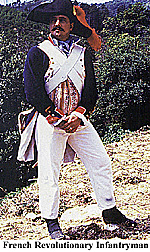 In the summer of 1995, men dressed in
threadbare uniforms of the French Revolutionary period had taken the Doria
Palace by storm. Then, at bayonet point, the Austrian defenders of the 16th
century town hall of Loano were hereded into the town square along with a good
number of municipal employees, and for good measure, the mayor.
In the summer of 1995, men dressed in
threadbare uniforms of the French Revolutionary period had taken the Doria
Palace by storm. Then, at bayonet point, the Austrian defenders of the 16th
century town hall of Loano were hereded into the town square along with a good
number of municipal employees, and for good measure, the mayor.
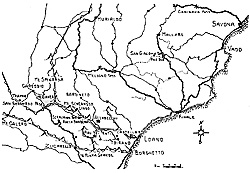
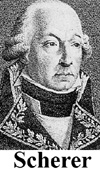 French reinforcements were in fact beginning to arrive.
6,000 men came from the Rhine and 10,000 from Spain,
but the final addition to the Armee d'Italie was only 12,000
men - the difference being caused by strategic consumption.
With them on 21 September arrived General Barthelemy Scherer
who replaced Kellerman, transferred to Armee des Alpes.
French reinforcements were in fact beginning to arrive.
6,000 men came from the Rhine and 10,000 from Spain,
but the final addition to the Armee d'Italie was only 12,000
men - the difference being caused by strategic consumption.
With them on 21 September arrived General Barthelemy Scherer
who replaced Kellerman, transferred to Armee des Alpes.
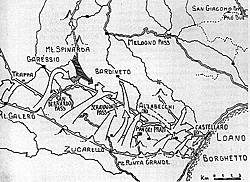
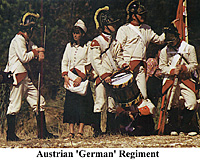 The French soldiers were shabbily dressed, but their Austrian
colleagues suffered in equal measure since their clothes and
equipment were worn-out by the long campaign too. The units,
therefore, began to disperse and withdraw to the zone behind the
front line. The French thought it would be easy to seize this
opportunity to advance but, approaching the Austrian quarters, the
resistance stiffened. General Charlet succeeded in occupying the
important positions of Pian dei Prati abandoned by the Imperial troops.
The French soldiers were shabbily dressed, but their Austrian
colleagues suffered in equal measure since their clothes and
equipment were worn-out by the long campaign too. The units,
therefore, began to disperse and withdraw to the zone behind the
front line. The French thought it would be easy to seize this
opportunity to advance but, approaching the Austrian quarters, the
resistance stiffened. General Charlet succeeded in occupying the
important positions of Pian dei Prati abandoned by the Imperial troops.
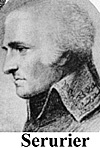 For the whole day their sector held off the right flank of the French, commanded by General Philibert Serurier, which concluded with both adversaries still occupying their original positions.
For the whole day their sector held off the right flank of the French, commanded by General Philibert Serurier, which concluded with both adversaries still occupying their original positions.
Battle of Loano (I)
Battle of Loano (II)
Loano Order of Battle
Re-enactment Photos (extremely slow: 743K)
Back to Age of Napoleon No. 21 Table of Contents
Back to Age of Napoleon List of Issues
Back to MagWeb Master List of Magazines
© Copyright 1997 by Partizan Press.
This article appears in MagWeb (Magazine Web) on the Internet World Wide Web.
Other military history articles and gaming articles are available at http://www.magweb.com